Wetpixel sperm whale expedition, update 2
Wetpixel Sperm Whale Expedition to Ogasawara Islands, Japan
Update 2: October 14, 2009
The typhoon to the east continued to throw huge swells into Ogasawara, resulting in extremely difficult conditions during our next couple of days out at sea. On day 3, we decided that the weather was too bad to make it out to the sperm whale area, so we turned around and stayed in the protection of the island’s lee. Luckily, we found a school of Indo-Pacific bottlenose dolphins (Tursiops aduncus) in the bay. Swimming with these dolphins are one of the reasons Japanese tourists flock to Ogasawara by the hundreds in high season, and when we jumped in, we could immediately see why. The dolphins simply swam through our small group of snorkelers, allowing us to get within mere feet of them.
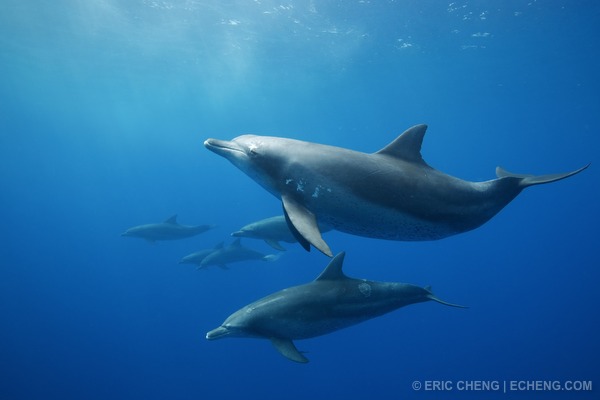
Indo-Pacific bottlenose dolphins (Tursiops aduncus) off of Chichijima, Ogasawara Islands, Japan
The dolphins appeared to still be partially asleep; one of them did do a few loopy loops with Emiko when she dove down to play, but quickly returned to the pod as they drifted lazily out into the open ocean where we were unable to go due to the aforementioned enormous swells. Tony attempted to lure some of the dolphins in by taking off his shirt and flexing (we all swooned at the sight of his bare pectorals); I’m not sure that his muscly technique worked to his satisfaction, but Tony did come back with a fantastic shot of the entire pod.
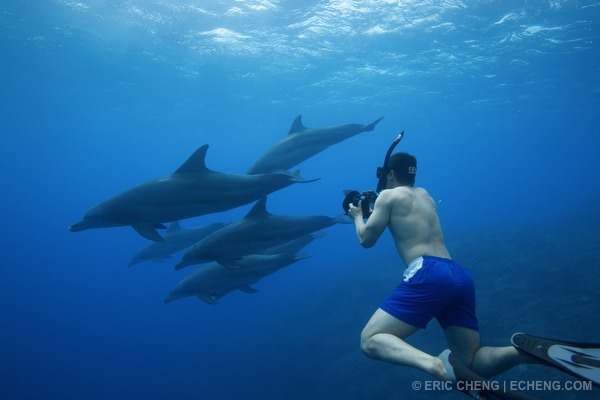
Tony Wu with Indo-Pacific bottlenose dolphins (Tursiops aduncus) off of Chichijima in the Ogasawara Islands, Japan
The next day (day 4), we awoke to beautiful blue skies and relatively calm seas. We motored out on the Dancing Whale to the 1000m ridge and found that the wind and chop of the previous day had vanished. There were still large swells—remnants of the typhoon to the east—but they rolled in gently and were easy to manage.

What a difference a few days makes!
And so, we had both sunshine and workable seas, but it turned out that there were no sperm whales to be found. The oceans were quiet both to our eyes and to the ears of the hydrophone Sea-Tac uses to listen to sperm whale activity (they echo-locate loudly—the popping, crackling, and wheezing cannot be missed). The most exciting feature of the day was the spit-up remains of a large pelagic octopus. Tony says that this sort of thing is relatively common in Ogasawara, since the sperm whales are here eating all sorts of deep-water cephalopods.
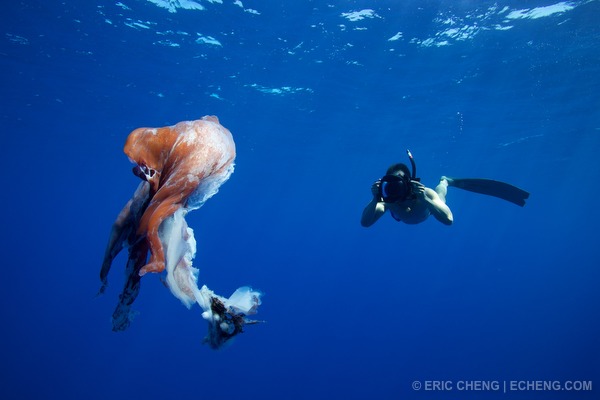
The remains of a large, pelagic octopus, presumably spit up by a sperm whale.
Today (day 5) was absolutely gorgeous! The sun was shining brightly, and the ocean was nearly flat calm. Best of all, sperm whale activity was off the charts. We followed individuals and mother/calf pairs around for awhile before stumbling serendipitously into frenetic bird activity. Excited, we jumped into the water and discovered the scattered remains of a large squid.

Squid remains were scattered in a trail behind a group of sperm whales—check out the teeth on the suckers!
It looked as if the squid was torn apart in relatively shallow water. As we floated around investigating squid remains, four sperm whales surfaced not far from us. Soon after, they were joined by a mother and calf we had been in the water with earlier in the day. We had ourselves a social group—very exciting! In the six years Douglas spent with sperm whales in the Azores, he only witnessed four social groups, so having one materialize on day 5 of our trip was indeed lucky. But it gets better: when we first saw the group underwater, we noticed that the largest female of the group was swimming with her mouth open—strange, to be sure. Upon closer inspection, we noticed that she had a large balled-up squid in her mouth! I’m told that this is *extremely* rare to see, and even rarer to see in a photo.
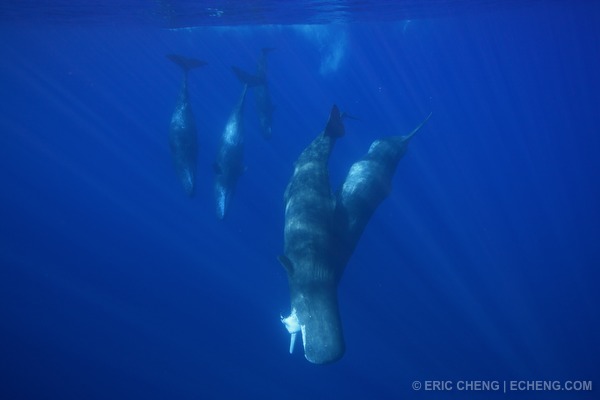
Six sperm whales (Physeter macrocephalus) dive down following a large female, who has a balled-up large squid in her mouth. If you’re counting, the 6th sperm whale is a small calf hiding behind the large female. (Ogasawara Islands, Japan)
We spent the rest of the afternoon making jumps on the social group. They didn’t seem to mind our presence that much, but none of the whales took any interest in us, meaning that all of our encounters consisted of slow, single passes. Still, we were all on a high—most of us managed to get shots with all six sperm whales in a single frame.
We also had some really close encounters. I found that my Tokina 17mm lens (full frame) was not quite wide enough for sperm whales that decided to get really close, but I did manage to get a few shots of them just filling the frame (also very close!).
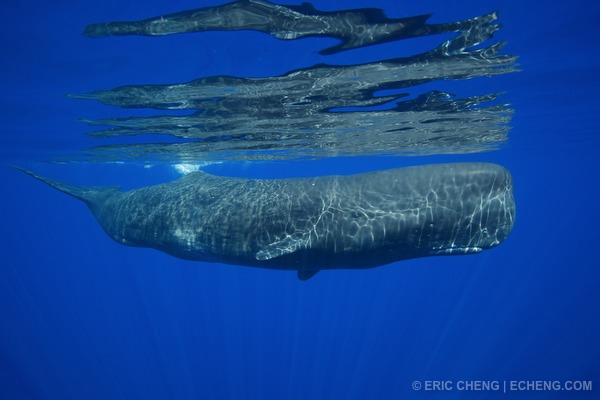
A large sperm whale (Physeter macrocephalus) comes in for a close look (Ogasawara Islands, Japan)
Earlier in the day, Tony, Emiko and Douglas swam madly while following a seemingly bored sperm whale, which then dove down a bit, turned around, and surfaced within just a few feet of them. It must have been rather exciting to have the largest predator in the world investigating from below!
Ogasawara
I love Ogasawara. It has the small island charm of Hawaii without the feeling of being overdeveloped and overrun by tourists. The ferry does potentially bring in hundreds of tourists each week, but it is typically only here for a few days at a time before it returns to Tokyo, meaning that there are contiguous days in which the town gets really sleepy—perfect, for my tastes. We have been going to a new restaurant each day, and have found local food to be incredibly tasty.
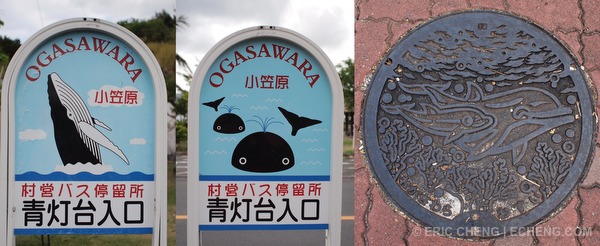
Everything in Ogasawara is cetacean-themed.
I wish I could post more photos of Ogasawara now, but I’ll have to save them for a longer trip report. There is almost no internet access here, and using Douglas’ Blackberry to send updates has its limits.
Other updates:
- Update 01, October 11, 2009
- Update 02, October 14, 2009
- Update 03, October 17, 2009